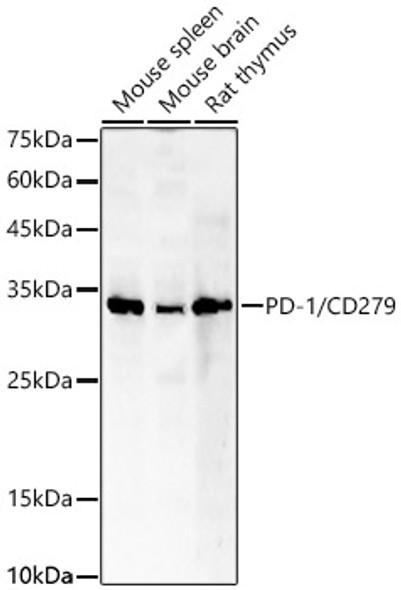Description
| Antibody Name: | Purified Human CD279/PD-1 Monoclonal Antibody |
| Antibody Code: | AGEL1607 |
| Size: | 100µg |
| Clone: | J116 |
| Synonyms: | PD-1, Programmed Death-1 |
| Host Species: | Mouse |
| Species Reactivity: | Human |
| Applications: | FC, IHC, IP |
| Concentration: | 1mg/mL |
| Isotype: | IgG2a,k |
| Conjugation: | Unconjugated |
| Applications: | FC, IHC, IP |
| Recommended Dilution: | Each lot of this antibody is quality control tested by immunofluorescent staining with flow cytometric analysis. For flow cytometric staining, the suggested use of this reagent is ≤ 1.0 µg per 10e6 cells in 100 µL volume or 100 µL of whole blood. It is recommended that the reagent be titrated for optimal performance for each application. |
| Storage Buffer: | PBS with 0.05% Proclin300 |
| Storage: | Store at 2-8°C. Do not freeze. |
| Gene ID: | 5133 |
| Uniprot: | Q15116 |
| Background: | Programmed cell death 1 (PD-1), also known as CD279, is a 55 kD member of the immunoglobulin superfamily. CD279 contains the immunoreceptor tyrosine-based inhibitory motif (ITIM) in the cytoplasmic region and plays a key role in peripheral tolerance and autoimmune disease. CD279 is expressed predominantly on activated T cells, B cells, and myeloid cells. PD-L1 (B7-H1) and PD-L2 (B7-DC) are ligands of CD279 (PD-1) and are members of the B7 gene family. Evidence suggests overlapping functions for these two PD-1 ligands and their constitutive expression on some normal tissues and upregulation on activated antigen-presenting cells. Interaction of CD279 ligands results in inhibition of T cell proliferation and cytokine secretion. |

 Purified Human CD279/PD-1 Monoclonal Antibody [J116](AGEL1607)](https://cdn11.bigcommerce.com/s-rd6ounxcu2/images/stencil/608x608/products/12558/16610/purified-human-cd279pd-1-monoclonal-antibody-j116agel1607__07089__94065.1706270064.jpg?c=1)
 AF/LE Purified Human CD279/PD-1 Monoclonal Antibody [J116](AGEL1606)](https://cdn11.bigcommerce.com/s-rd6ounxcu2/images/stencil/590x590/products/12557/16609/afle-purified-human-cd279pd-1-monoclonal-antibody-j116agel1606__97295__42602.1706270064.jpg?c=1)
 AF/LE Purified Human CD279/PD-1 Monoclonal Antibody [J110](AGEL2093)](https://cdn11.bigcommerce.com/s-rd6ounxcu2/images/stencil/590x590/products/12983/17035/afle-purified-human-cd279pd-1-monoclonal-antibody-j110agel2093__54111__79046.1706270214.jpg?c=1)


 Purified Mouse CD279/PD-1 Monoclonal Antibody [29F.1A12](AGEL1625)](https://cdn11.bigcommerce.com/s-rd6ounxcu2/images/stencil/590x590/products/12572/16624/purified-mouse-cd279pd-1-monoclonal-antibody-29f.1a12agel1625__95704__06787.1706270068.jpg?c=1)